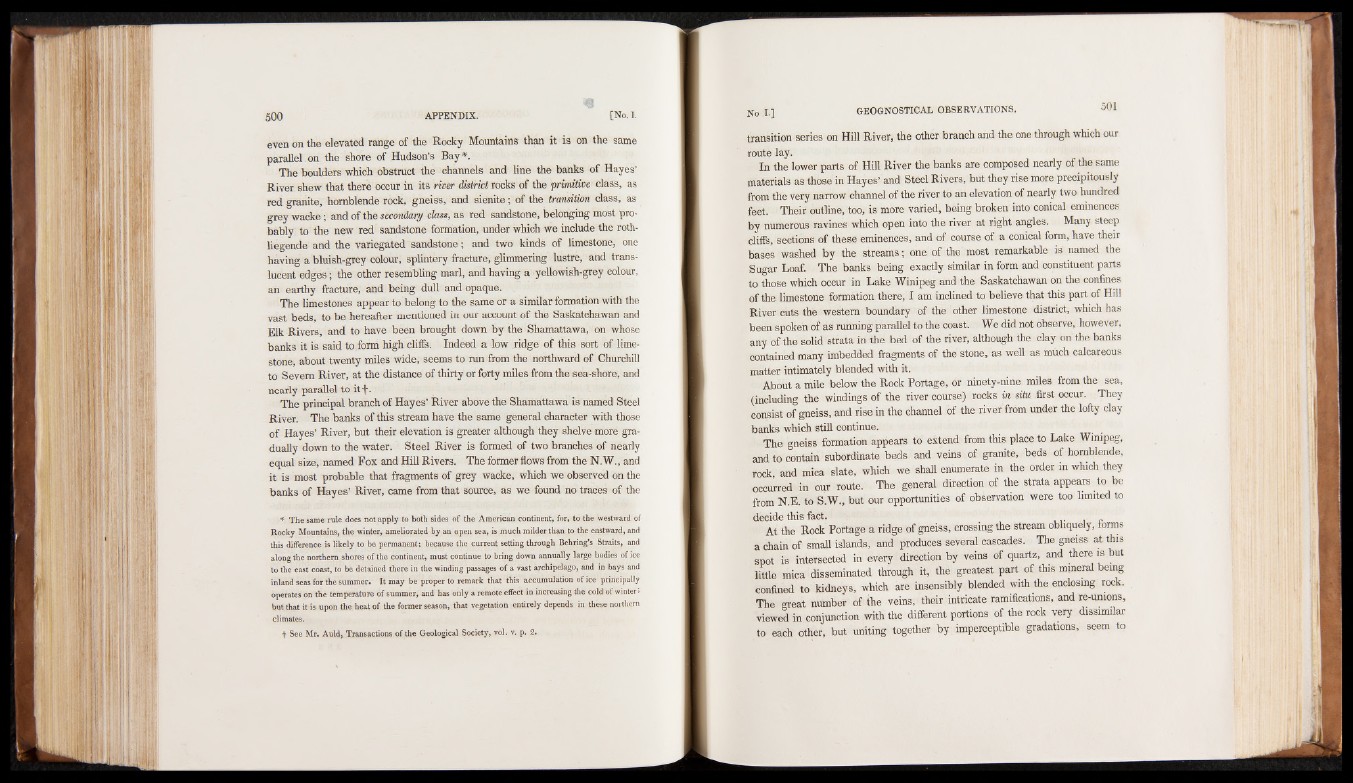
even on the elevated range of the Rocky Mountains than it is on the same
parallel on the shore of Hudson’s Bay*.
The boulders which obstruct the channels and line the banks of Hayes’
River shew that there occur in its river district rocks of the primitive class, as
red granite, hornblende rock, gneiss, and sienite; of the transition class, as
greywacke; and ofthe secondary class, as red sandstone, belonging most probably
to the new red sandstone formation, under which we include the roth-
liegende and the variegated sandstone; and two kinds of limestone, one
having a bluish-grey colour, splintery fracture, glimmering lustre, and translucent
edges; the other resembling marl, and having a yellowish-grey colour,
an earthy fracture, and being dull and opaque.
The limestones appear to belong to the same or a similar formation with the
vast beds to be hereafter mentioned in our account of the Saskatchewan and
Elk Rivers and to have been brought down by the Shamattawa, on whose
banks it is said to form high cliffs. Indeed a low ridge of this sort of limestone,
about twenty miles wide, seems to run from the northward of Churchill
to Severn River, at the distance of thirty or forty miles from the sea-shore, and
nearly parallel to it-)-.
The principal branch of Hayes’ River above the Shamattawa is named Steel
River. The banks of this stream have the same general character with those
of Hayes’ River, but their elevation is greater although they shelve more gradually
down to the water. Steel River is formed of two branches of nearly
equal size, named Fox and Hill Rivers. The former flows from the N.W., and
it is most probable that fragments of grey wacke, which we observed on the
banks of Hayes’ River, came from that source, as we found no traces of the
* The same rule does not apply to both sides of the American continent, for, to the westward of
Rocky Mountains, the winter, ameliorated by an open sea, is much milder than to the eastward, and
this difference is likely to be permanent; because the current setting through Behring’s Straits, and
along the northern shores of the continent, must continue to bring down annually large bodies of ice
to the east coast, to be detained there in the winding passages of a vast archipelago, and in bays and
inland seas for the summer. It may be proper to remark that this accumulation of ice principally
operates on the temperature of summer, and has only a remote effect in increasing the cold of winter»
but that it is upon the heat of the former season, that vegetation entirely depends in these northern
climates.
f See Mr. Auld, Transactions of the Geological Society, vol. v. p. 2.
transition series on Hill River, the other branch and the one through which our
rouItne tlhaey .lower parts of Hill River the banks are composed nearly of the same
materials as those in Hayes’ and Steel Rivers, but they rise more precipitously
from the very narrow channel of the river to an elevation of nearly two hundred
feet. Their outline, too, is more varied, being broken into conical eminences
by numerous ravines which open into the river at right angles. Many steep
clifls, sections of these eminences, and of course of a conical form, have their
bases washed by the streams; one of the most remarkable is named the
Sugar Loaf. The banks being exactly similar in form and constituent parts
to those which occur in Lake Winipeg and the Saskatchawan on the confines
of the limestone formation there, I am inclined to believe that this part of Hill
River cuts the western boundary of the other limestone district, which has
been spoken of as running parallel to the coast. We did not observe, however,
any ofthe solid strata in the bed of the river, although the clay on the banks
contained many imbedded fragments of the stone, as well as much calcareous
matter intimately blended with it.
About a mile below the Rock Portage, or ninety-nine miles from the sea,
(including the windings of the river course) rocks in situ .first occur. They
consist of gneiss, and rise in the channel of the river from under the lofty clay
banTkhse wghniecihs ss tfiollr mcoanttiionnu ea.ppears to extend from this place to Lake Winipeg,
and to contain subordinate beds and veins of granite, beds of hornblende,
rock and mica slate, which we shall enumerate in the order in which they
occurred in our route. The general direction of the strata appears to be
from N.E. to S.W., but our opportunities of observation were too limited to
decAidt et hteh isR foacckt. Portage a ridge of gneiss, crossing the stream obliquely, forms
a chain of small islands, and produces several cascades. The gneiss at this
spot is intersected in every direction by veins of quartz, and there is but
little mica disseminated through it, the greatest part of this mineral being
confined to kidneys, which are insensibly blended with the enclosing rock.
The great number of the veins, their intricate ramifications, and re-unions,
viewed in conjunction with the different portions of the rock very dissimilar
to each other, but uniting together by imperceptible gradations, seem to